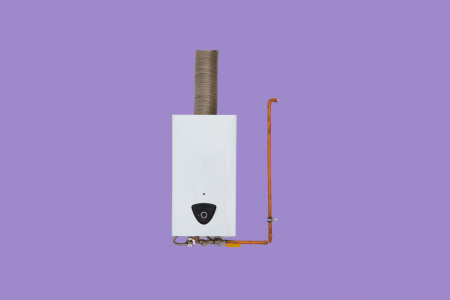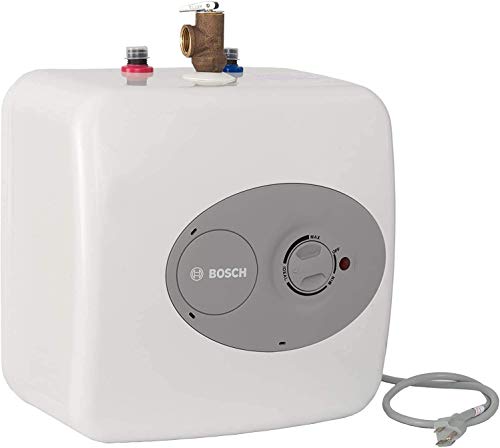Many people are disappointed when they realize that tankless water heaters don’t provide instant hot water. Somehow there was a mix up in interpretation between instant and endless hot water.
All on-demand means when it comes to tankless heaters is that the water gets heated when you turn on the faucet. It doesn’t mean you don’t have to wait for hot water.
Depending on how far the fixture is from the tankless heater, you could be waiting a while for that hot water to arrive.
In this article, I will go over how to get faster hot water when you have a tankless water heater.
Why Do Tankless Water Heaters Take So Long to Heat Up?
Think about how tankless water heaters work and compare it to a tank system.
With a tankless heater, cold water enters the heat exchanger. If you live in a cold climate then this water can be really cold. It takes time for the element to come up to temperature. The water is passing through the element as it heats up so the first water to reach you is the cold water in the pipes and then the lukewarm water that passed through the element before it was up to temperature.
Once you get the water coming through at the desired temperature, it stays that way indefinitely. Endless hot water.
A tank system is always heating water. That’s one of the downsides. When you shut off the water, the tank is now heating up the new water that arrived in the tank whether you want it or not. The water in the pipes is still hot until it cools down due to sitting there.
Now, neither one provides instant hot water, but usually, a tank system gets hot water to you faster.
How to Get Instant Hot Water With a Tankless Water Heater
It usually takes at least 10-15 seconds for a tankless heater to give hot water to every faucet or shower head. But there are definitely some things you can do to achieve instant hot water. Here are a few.
Point of Use Tankless Water Heater
One option to get hot water faster is to use a point-of-use tankless heater. These are electric units that typically fit under your sink or in a closet- ideal for homes without a gas line or propane.
However, keep in mind that these units aren’t ideal if you are looking for hot water for your entire house. Not only do they last about half as long as their gas unit counterparts, but their Btu output is quite low.
But if you are looking to go this route, Bosch makes a great under sink point of use water heater.
- CONVENIENT HOT WATER HEATER: 4 gallon point-of-use mini-tank fits under...
- LONG LASTING QUALITY: This electric water heater is easy to maintain and...
- INDEPENDENT INSTALLATION: 36-37" cord plugs into a 120 volt outlet for...
- FAST RECOVERY RATE: Eliminates long waits for hot water at your sink, get...
- EASILY MOUNTED: Can be shelf, wall or floor mounted (bracket included);...
Higher Efficiency Condensing Water Heater
Tankless water heater technology continues to improve and it’s quite possible you need a more efficient unit to get hot water faster. And this means a condensing water heater.
Condensing water heaters are not only about 20% more efficient that standard tankless heaters, but they save space. The efficiency stems from a second heat exchanger which allows the efficient utilization of excess heat.
If you’re looking for a condensing water heater, just be aware that these units are more expensive. It might not be necessary based on your hot water needs.
Demand Hot Water Systems
Demand hot water systems give you very fast hot water, although not quite as fast as recirculating systems.
Demand hot water systems use a pump connected to your water lines, that when activated, takes hot water from your water heater and pushes cold water to your cold line. This results in faster hot water.
The great thing about demand systems is that they can be retrofitted to your home and they save money, water, and energy.
Recirculating Pumps for Instant Hot Water
Another way to get instant hot water for your tankless is to have a recirculating pump. The way they work is to create a loop from the heater to your fixture. A thermostat detects when the water is cooling down and trips the heater to heat the water.
Read More!
To read up on all the details about the best recirculating pumps, click that link to read the article!
As soon as you turn on the faucet you have hot water. Basically, there is always hot water in the pipes circulating back to the heater as the water cools.
If you haven’t already bought your tankless water heater and want instant hot water, then make sure you buy one that already has the recirculating pump. Some don’t have the pump already but are set up with the capability to add one.
Tankless Water Heaters with Recirculating Pumps
Not every tankless has that capability, so if this is important to you then you have to make sure you get the right kind.
Here is a list of tankless water heaters that already have a recirculating pump built in. These are your best instant hot water tankless options.
What are the Options For a Recirculating Pump?
You have two options when it comes to setting up your recirculating pump.
Create a dedicated loop
You can have a plumber set up a series of pipes that create a loop from your heater to your fixtures and then back to the heater.
The downside to this is that it is expensive to set up. You’ll need to pay a plumber his usual labor cost plus the amount of pipe needed. How much pipe length you need depends on how far the furthest fixture is from the heater.
The recirculating pump is installed directly on the tankless heater itself so you’ll need a power source nearby.
Some houses already have this dedicated loop already installed so it pays to check it out as you may already be set up without needing one installed.
Read More!
To know which system is best for you, you have to read up on it. Here is an article about the pros and cons of hot water recirculating pumps. Click that link and then come back to read on.
Under-sink comfort system
To avoid the expense of adding a loop of pipes to circulate the hot water, you can install a comfort system under the sink. In this case, there is a sort of toggle that connects the hot and cold water lines under your sink. As the water is heated, the water runs into the cold water pipe leading it back to the heater. When the pump is on, there will always be hot water right at the fixture as soon as you turn it on.
There is a downside, of course. Since you don’t have a dedicated loop, you may end up with lukewarm cold water or have to wait for the water to get cold at the fixture.
Which system makes the most sense for you depends highly on your budget.
You can install a comfort system yourself and many of them work with a tankless heater, thus saving money.
Creating a dedicated loop is expensive and not something you can do yourself. You’ll need a licensed plumber and will need to check to make sure the pump is compatible with your tankless water heater model.
Many of the recirculating pumps available have timers so they are not running all day. You can set them up to only heat the water in the pipes at the times when you are home and usually need hot water.
Recirculating Pumps You Can Use With a Tankless Water Heater
There are some recirculating pumps that explicitly state that they are not meant for use with a tankless water heater and others that say they are.
The reality is it depends more on the tankless water heater than it does the pump.
In the above section, I listed the on-demand water heaters that are already have built in recirculating pumps. Make sure you check that out if you haven’t already and then circle back here.
Read More!
If you are on the fence about whether you should get a tankless water heater at all, then read this article about whether a tankless is worth it for you.
Here are a couple of tankless water heaters that are recirculating pump ready so you can use any pump with these:
- Energy Efficient Continuous Hot Water for the Whole Home
- Low operating cost - High energy efficiency and water savings setting
- Space Savings - Compact, space-saving design. Perfect for a tank...
- Water & Gas Leak Detection will shut down unit and provide an error code
- For use indoor only
- Original Design: Tankless hot water heater's Circ-Logic technology offers...
- Never Run Out of Hot Water with this Compact Tankless Gas Water Heater:...
- Smart, Durable Design: Includes 12-, 5-, and 1-year residential guarantee...
- Professional Installation Recommended: Visit the Find a Rinnai PRO page on...
- Find Your Rinnai: See our product guides, manuals, energy guide, warranty...
FAQ About Tankless Heaters and Instant Hot Water
If your fixture is next to your tankless water heater, water will get hot in a few seconds. And point-of-use tankless heaters give you almost instant hot water since they are right under your sink. However, if your fixture is on the opposite end of a large house or a couple of floors up, expect hot water in up to a minute.
The thickness and material of the pipes is also a factor.
It only takes 15 seconds for the water entering the heat exchanger to come up to the set temperature. This depends on how high your temperature is set, and how cold the water is as it enters. Generally, not more than 15 seconds with cold water and high-temperature settings, however.
Also, if your tankless uses less than 140,000 BTUs then it may take a little bit longer to heat the water to the desired temperature.
Usually, people set their tankless to 120°F to 140°F. The best temperature is at 110°F, however, so you don’t have to mix cold water when showering or washing your hands.
You’ll get higher Gallons Per Minute (GPM) by keeping the temperature lower. The downside is that your washing machine and dishwasher need the water to be hotter, hence, people keep the temperature high.
Although water heater boosters are for tank systems, this is a fairly common question. But no, water heater boosters won’t give you instant hot water. A water heater booster is great for increasing the quantity of hot water available. Unfortunately it does not help you get hot water faster.
Wrapping It Up
I hope this cleared up the confusion about whether a tankless water heater provides instant hot water or not.
I do believe they are worth it even considering that you will need a recirculating pump to get faster hot water.
No situation is 100% ideal so you really need to understand your needs and wants before making a hard and fast decision.

Nick Lopresti is the founder of YourH2Home and a home improvement expert. He has years of experience writing about various home improvement topics, mostly as it pertains to water systems.








